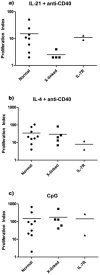Post-transplantation B cell function in different molecular types of SCID
- PMID: 23001410
- PMCID: PMC3549311
- DOI: 10.1007/s10875-012-9797-6
Post-transplantation B cell function in different molecular types of SCID
Abstract
Purpose: Severe combined immunodeficiency (SCID) is a syndrome of diverse genetic cause characterized by profound deficiencies of T, B and sometimes NK cell function. Non-ablative HLA-identical or rigorously T cell-depleted haploidentical parental bone marrow transplantation (BMT) results in thymus-dependent genetically donor T cell development in the recipients, leading to a high rate of long-term survival. However, the development of B cell function has been more problematic. We report here results of analyses of B cell function in 125 SCID recipients prior to and long-term after non-ablative BMT, according to their molecular type.
Methods: Studies included blood immunoglobulin measurements; antibody titers to standard vaccines, blood group antigens and bacteriophage Φ X 174; flow cytometry to examine for markers of immaturity, memory, switched memory B cells and BAFF receptor expression; B cell chimerism; B cell spectratyping; and B cell proliferation.
Results: The results showed that B cell chimerism was not required for normal B cell function in IL7Rα-Def, ADA-Def and CD3-Def SCIDs. In X-linked-SCID, Jak3-Def SCID and those with V-D-J recombination defects, donor B cell chimerism was necessary for B cell function to develop.
Conclusion: The most important factor determining whether B cell function develops in SCID T cell chimeras is the underlying molecular defect. In some types, host B cells function normally. In those molecular types where host B cell function did not develop, donor B cell chimerism was necessary to achieve B cell function. 236 words.
Figures

 , IgM X and IgE
, IgM X and IgE
 : prior to (a) and at the latest time studied after (b) rigorously T cell-depleted nonablative related donor bone marrow transplantation. The symbols represent individual patients, the bars the means and the vertical lines 2 SD above and below the means. Normal control values are for age 6 months in (a) and for older children and adults in (b).
: prior to (a) and at the latest time studied after (b) rigorously T cell-depleted nonablative related donor bone marrow transplantation. The symbols represent individual patients, the bars the means and the vertical lines 2 SD above and below the means. Normal control values are for age 6 months in (a) and for older children and adults in (b).
 , IgM X and IgE
, IgM X and IgE
 : prior to (a) and at the latest time studied after (b) rigorously T cell-depleted nonablative related donor bone marrow transplantation. The symbols represent individual patients, the bars the means and the vertical lines 2 SD above and below the means. Normal control values are for age 6 months in (a) and for older children and adults in (b).
: prior to (a) and at the latest time studied after (b) rigorously T cell-depleted nonablative related donor bone marrow transplantation. The symbols represent individual patients, the bars the means and the vertical lines 2 SD above and below the means. Normal control values are for age 6 months in (a) and for older children and adults in (b).






Similar articles
-
T cell repertoire development in humans with SCID after nonablative allogeneic marrow transplantation.J Immunol. 2003 Mar 1;170(5):2711-8. doi: 10.4049/jimmunol.170.5.2711. J Immunol. 2003. PMID: 12594301
-
Thymic output, T-cell diversity, and T-cell function in long-term human SCID chimeras.Blood. 2009 Aug 13;114(7):1445-53. doi: 10.1182/blood-2009-01-199323. Epub 2009 May 11. Blood. 2009. PMID: 19433858 Free PMC article.
-
B cell function after haploidentical in utero bone marrow transplantation in a patient with severe combined immunodeficiency.Bone Marrow Transplant. 2002 Apr;29(7):625-8. doi: 10.1038/sj.bmt.1703410. Bone Marrow Transplant. 2002. PMID: 11979315
-
Relationship between patterns of engraftment in peripheral blood and immune reconstitution after allogeneic bone marrow transplantation for (severe) combined immunodeficiency.Blood. 1994 Dec 1;84(11):3936-47. Blood. 1994. PMID: 7949150 Review.
-
B-cell reconstitution for SCID: should a conditioning regimen be used in SCID treatment?J Allergy Clin Immunol. 2013 Apr;131(4):994-1000. doi: 10.1016/j.jaci.2013.01.047. Epub 2013 Mar 5. J Allergy Clin Immunol. 2013. PMID: 23465660 Free PMC article. Review.
Cited by
-
Hematopoietic Stem Cell Transplantation for Severe Combined Immunodeficiency (SCID).Front Pediatr. 2019 Nov 19;7:481. doi: 10.3389/fped.2019.00481. eCollection 2019. Front Pediatr. 2019. PMID: 31803700 Free PMC article. Review.
-
B-cell differentiation and IL-21 response in IL2RG/JAK3 SCID patients after hematopoietic stem cell transplantation.Blood. 2018 Jun 28;131(26):2967-2977. doi: 10.1182/blood-2017-10-809822. Epub 2018 May 4. Blood. 2018. PMID: 29728406 Free PMC article. Clinical Trial.
-
Hematopoietic stem cell transplantation for primary immunodeficiencies.Hematol Oncol Clin North Am. 2014 Dec;28(6):1157-70. doi: 10.1016/j.hoc.2014.08.006. Epub 2014 Sep 16. Hematol Oncol Clin North Am. 2014. PMID: 25459185 Free PMC article. Review.
-
Long-Term Outcomes of Hematopoietic Stem Cell Transplantation for ZAP70 Deficiency.J Clin Immunol. 2016 Oct;36(7):713-24. doi: 10.1007/s10875-016-0316-z. Epub 2016 Jul 20. J Clin Immunol. 2016. PMID: 27438785
-
Defects in mucosal immunity and nasopharyngeal dysbiosis in HSC-transplanted SCID patients with IL2RG/JAK3 deficiency.Blood. 2022 Apr 28;139(17):2585-2600. doi: 10.1182/blood.2021014654. Blood. 2022. PMID: 35157765 Free PMC article.
References
-
- Buckley RH, Schiff SE, Schiff RI, Markert L, Williams LW, Roberts JL, et al. Hematopoietic stem cell transplantation for the treatment of severe combined immunodeficiency. N Engl J Med. 1999 Feb 18;340:508–16. - PubMed
-
- Myers LA, Patel DD, Puck JM, Buckley RH. Hematopoietic stem cell transplantation for severe combined immunodeficiency in the neonatal period leads to superior thymic output and improved survival. Blood. 2002 Feb 1;99(3):872–8. - PubMed
-
- Puck JM, Deschenes SM, Porter JC, Dutra AS, Brown CJ, Willard HF, et al. The interleukin-2 receptor gamma chain maps to Xq13.1 and is mutated in X-linked severe combined immunodeficiency, SCIDX1. Human Molecular Genetics. 1993;2:1099–104. - PubMed
-
- Noguchi M, Yi H, Rosenblatt HM, Filipovich AH, Adelstein S, Modi WS, et al. Interleukin-2 receptor gamma chain mutation results in X-linked severe combined immunodeficiency in humans. Cell. 1993;73:147–57. - PubMed
Publication types
MeSH terms
Grants and funding
LinkOut - more resources
Full Text Sources
Medical
Research Materials

